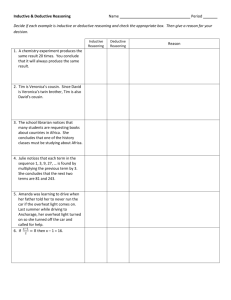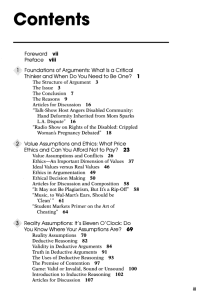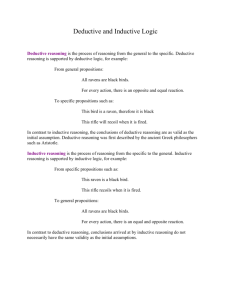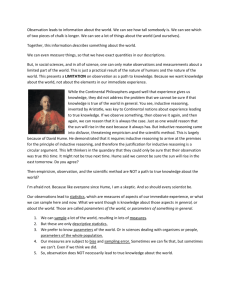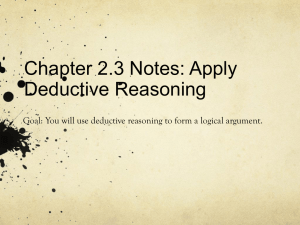Ross English 11 AP – English Literature and Composition Deductive
advertisement
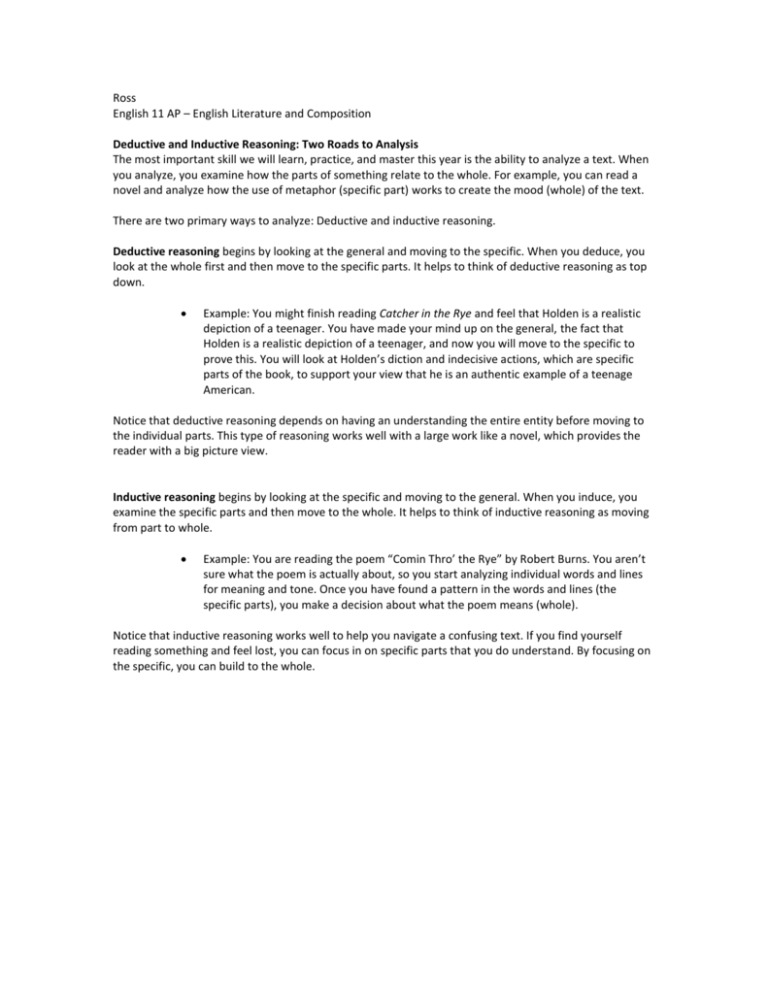
Ross English 11 AP – English Literature and Composition Deductive and Inductive Reasoning: Two Roads to Analysis The most important skill we will learn, practice, and master this year is the ability to analyze a text. When you analyze, you examine how the parts of something relate to the whole. For example, you can read a novel and analyze how the use of metaphor (specific part) works to create the mood (whole) of the text. There are two primary ways to analyze: Deductive and inductive reasoning. Deductive reasoning begins by looking at the general and moving to the specific. When you deduce, you look at the whole first and then move to the specific parts. It helps to think of deductive reasoning as top down. Example: You might finish reading Catcher in the Rye and feel that Holden is a realistic depiction of a teenager. You have made your mind up on the general, the fact that Holden is a realistic depiction of a teenager, and now you will move to the specific to prove this. You will look at Holden’s diction and indecisive actions, which are specific parts of the book, to support your view that he is an authentic example of a teenage American. Notice that deductive reasoning depends on having an understanding the entire entity before moving to the individual parts. This type of reasoning works well with a large work like a novel, which provides the reader with a big picture view. Inductive reasoning begins by looking at the specific and moving to the general. When you induce, you examine the specific parts and then move to the whole. It helps to think of inductive reasoning as moving from part to whole. Example: You are reading the poem “Comin Thro’ the Rye” by Robert Burns. You aren’t sure what the poem is actually about, so you start analyzing individual words and lines for meaning and tone. Once you have found a pattern in the words and lines (the specific parts), you make a decision about what the poem means (whole). Notice that inductive reasoning works well to help you navigate a confusing text. If you find yourself reading something and feel lost, you can focus in on specific parts that you do understand. By focusing on the specific, you can build to the whole. Part I – Deductive Reasoning On the board is the famous painting The Raft of the Medusa by the French Romantic painter Theodore Gericault. Géricault drew his inspiration from the account of two survivors of the Medusa—a French Royal Navy frigate that set sail in 1816 to colonize Senegal. It was captained by an officer of the Ancien Régime who had not sailed for over twenty years and who ran the ship aground on a sandbank. Due to the shortage of lifeboats, those who were left behind had to build a raft for 150 souls—a construction that drifted away on a bloody 13-day odyssey that was to save only 10 lives. The disaster of the shipwreck was made worse by the brutality and cannibalism that ensued (www.louvre.fr/en/oeuvre-notices/raft-medusa). Needless to say, this painting depicts a brutal moment in human history. But how does Gericault do this so effectively? Use deductive reasoning to examine how specific elements in the painting make this a powerful depiction of tragedy Thesis (Whole): The Raft of the Medusa is a depiction of human tragedy. Evidence (Parts): 1. 2. 3. 4. 5. 6. 7. 8. 9. 10. Part II – Inductive Reasoning Now that we have practiced using deductive reasoning, we will move to the use of inductive reasoning. On the board you will see a famous and controversial painting. The exact message of this painting has divided those who have seen it for over a century. Look at the individual elements of the painting to determine whether it is a depiction of human tragedy or a depiction of the power of hope and the human spirit. Thesis (Whole): Evidence (Parts): 1. 2. 3. 4. 5. 6. 7. 8. 9. 10. Painting #2 – Landscape by Brueghel Now that we have practiced as a class, it is time for you to try this in pairs. Look at the individual elements of the painting to determine its thesis (what it is trying to prove). List the evidence you find that helps to lead you to this thesis. (HINT: Make the decision to use either deductive or inductive reasoning.) Whole (Thesis): Parts: 1. 2. 3. 4. 5. 6. 7. 8. 9. 10. Painting #3 – Les Demoiselles d’Avignon by Picasso Now that we have practiced as a class and in pairs, it is time for you to try this on your own. Go online and examine the painting Les Demoiselles d’Avignon by Picasso. Look at the individual elements of the painting to determine its thesis (what it is trying to prove). List the evidence you find that helps to lead you to this thesis. (HINT: Make the decision to use either deductive or inductive reasoning.) Whole (Thesis): Parts: 1. 2. 3. 4. 5. 6. 7. 8. 9. 10. Part III – Deductive vs. Inductive Reasoning 1. What are the limitations or possible problems inherent in deductive reasoning? 2. What are the limitations or possible problems inherent in inductive reasoning? 3. How will the use of both help you to analyze texts this year?
